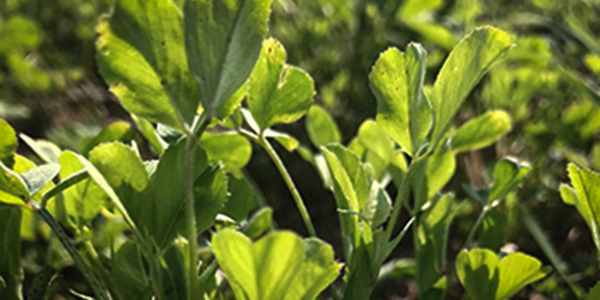AGRONOMICSUPPORT
YOU CAN TAKETO THE FIELD
Scouting Alfalfa Before Fall Dormancy
The late summer/early fall cutting of alfalfa should occur early enough so the plants can regrow, produce and store carbohydrates in the roots and crowns before entering fall dormancy. This will increase the chances of winter survival and speed up regrowth in springtime. Stand evaluation and soil sampling in the fall are also essential for estimating the yield potential, longevity of the stand and fertility levels.
Alfalfa needs a rest period from harvest about six to eight weeks prior to the first killing frost. In Wisconsin this usually occurs in roughly mid-September through mid-October. This occurs in Northern areas a bit earlier and in the southern areas a bit later. The resting period allows plants to rebuild carbohydrate reserves for winter survival and regrowth in the springtime. If plants are harvested during this time, the carbohydrates are depleted and spring regrowth will be slow and will have loss of some plants, which reduces the tonnage the following year. If harvest is made later then this timeframe and temps are cool enough, the alfalfa plant will not try to regrow and the carbohydrates will not be depleted.
Fall is an excellent time for stand evaluation. This can be done by counting stems/sq. ft. Older stands will have less plant but usually more stems out of each crown vs younger stands will have more plants with less stems. To evaluate your stand, measure a 12”x12” square and count stems within that square that are four to six inches tall. Repeat this in five to six locations to get an accurate evaluation of the field. If stem counts are less than 40, tough decisions need to be made about possible stand replacement. If counts are more than 50, yield potential can be considered excellent.
If stands are thin but not practical to destroy, consider interseeding with grasses or clover to help meet forage needs. Autotoxicity can occur if you attempt to reseed alfalfa into an existing stand, especially over two years of age. If the stand is less than one year of age, and pH and fertility are at recommended levels, then seeding alfalfa may be successful.
While you’re evaluating your stand, evaluate the soil’s fertility as well. Conduct a soil test to determine nutrient levels, especially pH, phosphorus and potassium. The recommended pH for alfalfa is 6.8 to 7.0. Each ton of alfalfa removes about 14 pounds of phosphate, 58 pounds of potash, 30 pounds of calcium, six pounds of magnesium and six pounds of sulfur. Fall is a great time to add fertilizer to stands of alfalfa to help minimize winter injury and boost productivity the following year.
Fall is a crucial time for the longevity of an alfalfa stand. Allowing alfalfa to rest six to eight weeks before frost is important, and evaluating the stand for long-term forage needs is a must in fall. Maintain a good fertility program for alfalfa to ensure winter survival and long-term stand establishment. Contact your local LG Seeds Technical Team Agronomist or STAR Partner with questions about alfalfa stand management.
Sources and additional information:
Wisconsin Extension and Outreach






Technical Team Agronomist